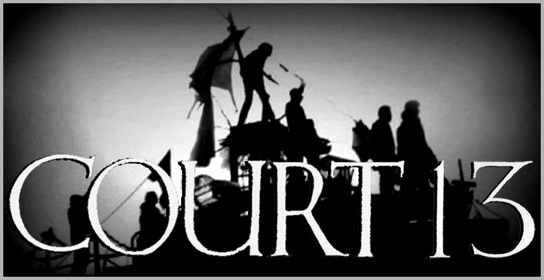_May508
Posted byMichael Tully
GLORY AT SEA - Pomp and Transcendence
http://www.hammertonail.com/?p=54
Every once in a rare, long while, a film appears with such a sweeping gust of rejuvenation that it has the power to restore not only one’s faith in cinema but in humanity as a whole. These miracles—some minor, some major—are truly blessed creations. They exist on a timeless plane, feeling both brand new and classic at the very same time. They are worlds unto themselves, borne out of a passionate vision, torn from the spiritual recesses of an individual’s soul and transferred miraculously onto the big screen. Benh Zeitlin’s Glory at Sea is one of these miracles. If ever a short film deserved to be written about as a feature, Glory at Sea is it. Which is what makes Zeitlin’s epic spectacle even more stunning. By the time the film’s closing credits appear—after just twenty-five minutes—it feels like one has been taken on a deeply lasting feature-length journey.
Conceived and executed by the youthful Court 13 collective—who is also responsible for the award-winning short Death to the Tinman—Glory at Sea ups the ante of Ray Tinori’s stylish, invigorating work (here, Tintori steps into the role of Production Designer) by telling the story of a group of individuals struggling to survive in an apocalyptic post-Katrina New Orleans. Zeitlin’s vision of a dilapidated future feels strangely archaic, as if the storm destroyed the past half-century of technology, instead leaving behind mementos of an earlier era (bathtub, wooden bed, acoustic guitar, trumpet, etc.). The residents in this flooded world have no use for technology, for without electricity, what good is technology? And without their families, what good is anything? Their only desire is to sail into the sea in order to reunite with their loved ones, who are submerged somewhere under all of that water. To do that, they must band together as a community—in the most spiritual sense of that word—and use their own hands to build a boat from scratch. All they’ve got is their undying spirit, hope, and love to keep them going. According to Zeitlin’s unapologetically sincere vision, that’s more than enough.
By all accounts, the production of Glory at Sea was a daring, reckless folly. Much like the world that was being created inside the frame, the filmmakers took a lived-in, hands-on, communal approach to the production. The result is a film that feels as if it’s on the verge of snapping into pieces at any given moment. Every shot is infused with throbbing, manic energy that reflects the “let’s go for it!” state-of-mind of each and every character, filling the screen with a relentless jolt of visceral, propulsive electricity. However, Zeitlin didn’t rest on his film’s visual laurels in capturing that frantic edge-of-the-world spirit. His original score, co-composed with and orchestrated by Dan Romer, sways and swells like the ocean itself, surging from soft, tender moments of smooth, quiet tides to melodic crescendos of forceful, crashing waves. Each of these technical attributes makes Glory at Sea a wonder to behold, but when placed on top of each other, the film becomes almost unbearable in its relentless assault upon the viewer’s emotional senses.
What ultimately makes Glory at Sea a truly landmark achievement—one that should be taught in film schools all across the country from this point forth, in fact—is the economy of its editing and overall pacing (compliments of Zeitlin and Crockett Doob). How often does one watch the work of a confirmed master and wish that master had understood the painful realization that more is not always better. It happens all the time, and yet no one seems to grasp this concept. Yet with Glory at Sea, Zeitlin has delivered a film refreshingly devoid of all filler. When he does slow down, it is only for a very brief moment, to let the worried preacher take stock of the collapsing world around him. Zeitlin certainly had more footage to incorporate, but adding exposition would have done nothing to add greater weight to the film’s overall impact. In this case, it might have detracted. If executed properly, one shot can express the thoughts and emotions of five or six. Glory at Sea is compiled of these singular moments, in which each and every shot carries the dramatic weight of several scenes. (Note: I am writing this after having watched the film almost ten times; on an initial solitary viewing the daring narrative presentation might feel jarring and oblique, but I have always been of the belief that one should watch their favorite films as often as they listen to their favorite records.)
If all of this mythical production lore and staggering technical proficiency were in the service of a lesser cause, Glory at Sea would still be required viewing. But the fact that Zeitlin has a deeply spiritual purpose is what makes it an absolute must-see. While the film is first and foremost about New Orleans, celebrating the undying spirit of that city and its people, it also succeeds as a universally uplifting tale about humanity on a grander scale. Glory at Sea celebrates hope and community and love in a world that is cruel and indifferent. To survive we must all stick together, we must love one another, we must believe. Without those grand human forces at work, we’ll never make it to the bottom of the sea to hug our loved ones once again.
— Michael Tully
Friday, September 19, 2008
Subscribe to:
Post Comments (Atom)

1 comment:
I came across Glory at Sea on youtube by chance, and from there to reviews of the film, including this one.
Never having watched a "featured youtube" before, I was puzzled at first at what I was watching, and then transfixed. This is one of the most moving of movies I've seen in my many decades of watching films - moving and one of the best, based on myth and yet so original.
Post a Comment